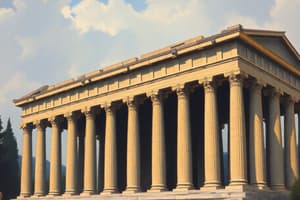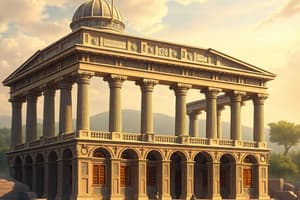Podcast
Questions and Answers
What is the primary reason why Greek temples have an even number of columns?
What is the primary reason why Greek temples have an even number of columns?
- To allow for the location of the entrance in the center (correct)
- To provide additional support for the temple's roof
- To honor the gods with an equal number of columns on each side
- To create a sense of symmetry and balance
What term is used to describe a temple with six columns in front?
What term is used to describe a temple with six columns in front?
- Diastyle
- Octastyle
- Tetrastyle
- Hexastyle (correct)
What is the purpose of the colonnades in Greek temples?
What is the purpose of the colonnades in Greek temples?
- To define a portico around the temple (correct)
- To support the weight of the temple's roof
- To provide additional interior space
- To create a sense of grandeur and opulence
What is the name of the rectangular space enclosed by the four walls of the temple?
What is the name of the rectangular space enclosed by the four walls of the temple?
What is the typical shape of the plan of a Greek temple?
What is the typical shape of the plan of a Greek temple?
What is the purpose of the podium in Greek temples?
What is the purpose of the podium in Greek temples?
How many columns are typically found on the side of a hexastyle temple?
How many columns are typically found on the side of a hexastyle temple?
What is the typical lighting condition of the interior of a Greek temple?
What is the typical lighting condition of the interior of a Greek temple?
What is the unique feature of the Temple of Aphaia at Aegina?
What is the unique feature of the Temple of Aphaia at Aegina?
What was the primary purpose of the temple's orientation towards the east?
What was the primary purpose of the temple's orientation towards the east?
What is the orientation of the Temple of Apollo Epicurius?
What is the orientation of the Temple of Apollo Epicurius?
What is the unique feature of the Temple of Apollo Epicurius in terms of orders?
What is the unique feature of the Temple of Apollo Epicurius in terms of orders?
Which of the following architects designed the Parthenon in 447 BC?
Which of the following architects designed the Parthenon in 447 BC?
What is the location of the only Corinthian column in the Temple of Apollo Epicurius?
What is the location of the only Corinthian column in the Temple of Apollo Epicurius?
What is the significance of the proportions of the Parthenon?
What is the significance of the proportions of the Parthenon?
What is the significance of the Agora in Greek cities during the Hellenistic period?
What is the significance of the Agora in Greek cities during the Hellenistic period?
How many columns does the Parthenon have in front and by its side?
How many columns does the Parthenon have in front and by its side?
What was the trend in Greek architecture during the Hellenistic period?
What was the trend in Greek architecture during the Hellenistic period?
What is the term used to describe the subtle curvature of the columns in the Parthenon?
What is the term used to describe the subtle curvature of the columns in the Parthenon?
What is the significance of the statue of Apollo in the Temple of Apollo Epicurius?
What is the significance of the statue of Apollo in the Temple of Apollo Epicurius?
What was the purpose of the smaller chamber in the Parthenon?
What was the purpose of the smaller chamber in the Parthenon?
What material was used to create the statue of Athena in the Parthenon?
What material was used to create the statue of Athena in the Parthenon?
What is the year range during which the Temple of Aphaia at Aegina was built?
What is the year range during which the Temple of Aphaia at Aegina was built?
What type of columns supported the roof of the Parthenon chamber?
What type of columns supported the roof of the Parthenon chamber?
Flashcards are hidden until you start studying
Study Notes
Temple Architecture
- The Temple of Aphaia at Aegina was built around 500 BC and has a unique hexastyle design with only 12 flanking columns.
- The interior columns are divided into a row of two columns, and the temple has triangular pediments on the Eastern and Western sides decorated with stories from Greek myths.
Temple of Aphaia at Aegina (continued)
- The temple was built between 420-400 BC and has a special entrance for the statue of Apollo, which faces east.
- Unlike most Greek temples, the Temple of Aphaia is aligned north-south, possibly due to local tradition or topography.
Temple of Apollo Epicurius at Bassae
- The temple combines Doric and Ionic orders in a single structure, which is unusual.
- The Doric order is used in the colonnades, while the naos features Ionic half columns, and a single Corinthian column is located at the end of the temple.
Architectural Characteristics of Greek Temples
- Greek temples feature orders (Doric, Ionic, Corinthian), façade elements, optical corrections, and plan organization.
Plan Organization of Greek Temples
- Greek temples are typically rectangular in plan, lifted on a podium, and feature colonnades on all external sides.
- The number of columns is always even to allow for a central entrance, with temples having odd numbers of columns being uncommon.
- The colonnades define a portico around the temple, and the temple interior is typically dark, with only the entrance providing light.
The Parthenon at Athens
- The Parthenon was designed by Ictinus and Callicrates in 447 BC and is considered the most perfect Doric temple ever built.
- It embodies the perfection of the Greek system of proportioning, based on the proportions of a man (7:1).
- The Parthenon is an octastyle temple with 8 columns in front and 17 columns by its side.
- It features entasis, and has a doubled chamber naos with a large chamber housing a statue of Athena and a smaller chamber housing a treasury.
The Parthenon (continued)
- The inside of the temple was often not used, and the roof of the Parthenon chamber was supported by delicate Ionic columns inside.
- A massive ivory and gold statue of Athena, 11 meters tall, once stood in the inner sanctuary of the Parthenon.
Studying That Suits You
Use AI to generate personalized quizzes and flashcards to suit your learning preferences.




